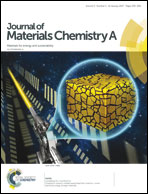Etched current collector-guided creation of wrinkles in steel-mesh-supported V6O13 cathode for lithium-ion batteries†
Abstract
Lithium-ion battery (LIB) technology is quite mature and so popular that it has now become an inseparable part of our lives. However, a major drawback in the current technology is the low energy density arising from the poor rate capacity of the electrode materials. One of the most important challenges in improving the energy density of LIBs is the morphological modification. In this study, a vanadium oxide cathode was fabricated via a facile two-step preparation protocol that included electrodeposition of a precursor, and then immersion conversion of that precursor. As the electrodeposition increased, the mass loading of the final product increased as well, which displayed a detrimental effect on the rate performance of the electrode. This negative effect from the mass loading was in fact a result of the increased film thickness that slowed down the lithium diffusion. To alleviate the counteracting effect from the increasing mass and to achieve a better rate capacity at a larger mass scale, a substrate etching strategy was adopted to create cavities, which were able to enlarge the electrode active area. The results obtained prove that the strategy outlined herein effectively attenuated the unfavorable effects brought by mass increase.


 Please wait while we load your content...
Please wait while we load your content...